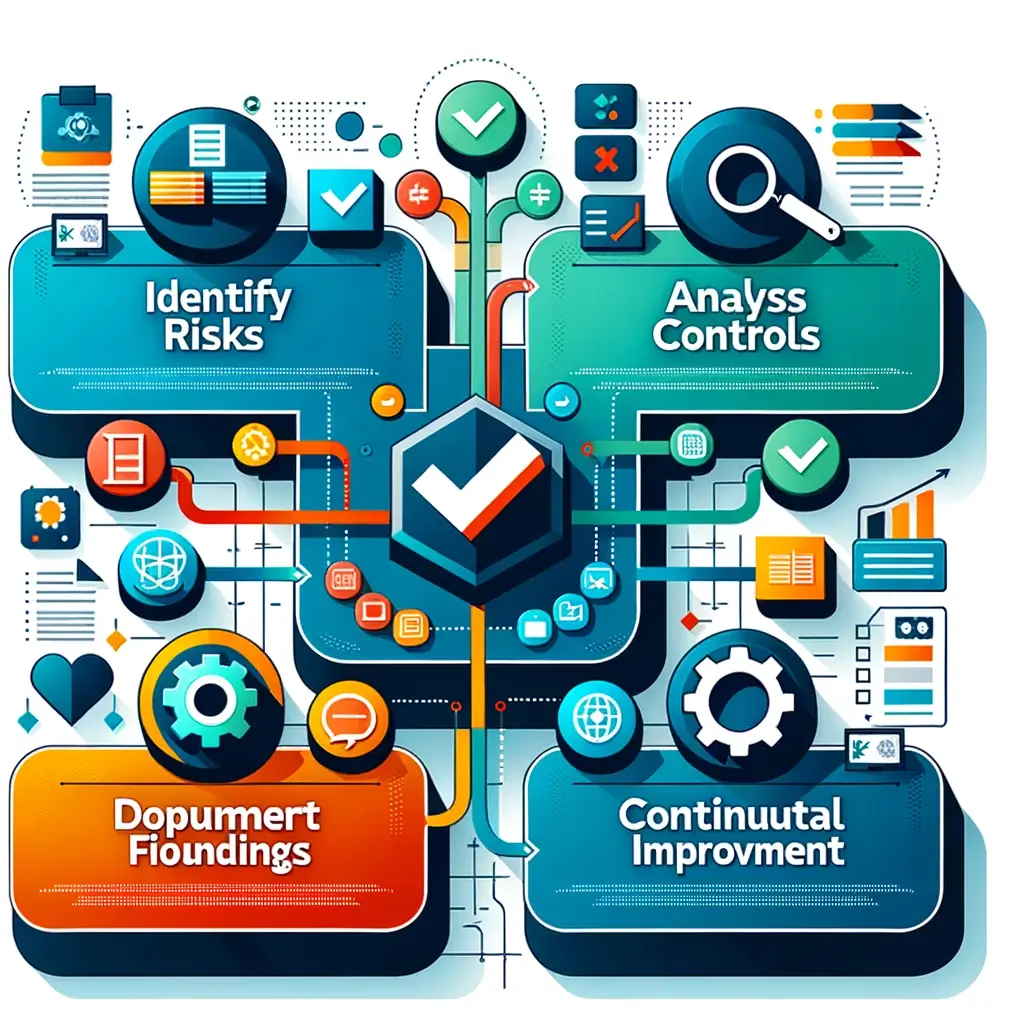In order to ensure effective compliance with RCSA regulations, organizations should also consider implementing the following best practices: Organizations can enhance their compliance with RCSA regulations and mitigate the risk of non-compliance.
This not only helps to protect the organization from potential legal and financial consequences but also fosters trust and confidence with stakeholders and customers. They include:-
- Review regulator expectations and requirements – Thoroughly research your specific regulator’s RCSA guidelines and expectations. This includes understanding reporting formats and frequency. (Treliant)
- Establish clear roles and responsibilities – Define who is responsible for performing assessments, remediating issues, approving results, and reporting to regulators. Accountability helps ensure compliance. (LogicGate)
- Automate the RCSA process – Leverage technology to conduct assessments, track remediation, and generate reports efficiently. Automation reduces compliance risks from human error. (LinkedIn)
- Senior management oversight – Ensure executive sponsorship and review of RCSA results to address any compliance deficiencies quickly. Management tone helps ensure ongoing compliance. (GAN Integrity)
Ensuring compliance with RCSA regulations is crucial for organizations to manage and mitigate risks effectively. In this article, we will explore four best practices that can help organizations achieve RCSA regulations compliance.

In addition, they can also include:
- Establishing a risk appetite: Organizations should define their risk appetite, which is the level of risk they are willing to accept in pursuit of their objectives. By clearly defining their risk appetite, organizations can align their risk management efforts with their strategic goals and make informed decisions about risk-taking.
- Developing an enterprise-wide RCSA program: A robust RCSA program involves the identification, assessment, and monitoring of risks across the entire organization. This program should be integrated into day-to-day operations and supported by adequate resources and technology. By implementing an enterprise-wide RCSA program, organizations can gain a holistic view of their risks and ensure consistent compliance with regulations.
- Creating an effective risk management culture: Organizations should foster a culture that values risk management and encourages employees at all levels to participate in identifying and managing risks actively. This involves promoting open communication, providing training and education on risk management, and recognizing and rewarding risk-aware behaviors.
Definition of RCSA
To understand the definition of RCSA, it is important first to have an overview of regulations compliance.
Regulations compliance refers to the adherence and fulfillment of laws, rules, and guidelines set by regulatory bodies to ensure ethical practices, risk mitigation, and accountability in various industries.
This includes implementing processes, controls, and reporting mechanisms to ensure that organizations operate in accordance with these regulations.
RCSA, or Risk control self-assessment, is a methodology used by organizations to assess and manage risks within their operations, with the ultimate goal of achieving regulatory compliance.
Overview of Regulations Compliance
Regulatory Compliance Self-Assessment (RCSA) is a structured process that enables organizations to evaluate their adherence to regulations and identify areas for improvement.
It involves assessing internal controls, operational risk, and regulatory risk to determine the effectiveness of an organization’s risk management practices and processes.
The RCSA process typically includes the following steps:
- Risk assessment: Identifying and assessing potential risks that could impact the organization’s ability to comply with regulations.
- Risk control self-assessment: Evaluating the adequacy and effectiveness of existing controls in managing identified risks.
- Risk management: Developing and implementing strategies to mitigate risks and improve compliance with regulations.
Best Practice 1: Establish a Risk Appetite
When it comes to regulatory compliance, establishing a risk appetite is crucial. This involves defining the level of risk that the organization is willing to accept and setting a risk appetite that aligns with regulatory requirements.
It is also important to ensure appropriate governance and oversight structures are in place to monitor and manage risks effectively.
Establishing a risk appetite, organizations can proactively address potential risks and ensure compliance with regulations.
Defining the Level of Risk Accepted
An essential step in ensuring compliance with RCSA regulations is to establish a clear and quantifiable risk appetite. This sets the foundation for defining the level of risk that an organization is willing to accept in its operations.
To effectively define the level of risk accepted, organizations should consider the following:
- Identify and prioritize the types of risks they face.
- Determine the acceptable level of risk for each identified risk.
- Engage risk owners and a cross-functional team to establish a comprehensive plan to manage and control the identified risks.
Establishing a risk appetite, organizations can better assess and manage their residual risks. It also helps create a robust control environment that aligns with the organization’s risk tolerance.
Defining the level of risk accepted provides clarity and enables proactive risk management, enhancing the overall compliance posture of the organization.
Setting a Risk Appetite for the Organization
To effectively set a risk appetite for the organization, it is crucial to establish a clear and quantifiable understanding of the level of risk accepted.
This involves identifying and evaluating the potential risks that the organization may face in achieving its objectives.
It is important to involve key stakeholders, including the board of directors, in the process to ensure alignment and buy-in. This can be done by defining specific measures that will be used to assess and monitor risks.
Additionally, the organization should foster a risk culture that promotes proactive identification and management of risks. The risk appetite should be aligned with the organization’s strategic objectives and risk management strategy.
Aligning the Risk Appetite with Regulatory Requirements
Aligning the risk appetite with regulatory requirements is a crucial step in ensuring compliance with RCSA regulations.
To achieve this alignment, organizations need to establish a risk appetite that aligns with the relevant regulatory requirements.
This involves understanding the risk control environment and the risk landscape in which the organization operates.
To align the risk appetite with regulatory requirements, organizations should consider the following:
- Conducting a comprehensive risk assessment to identify the risks associated with regulatory non-compliance.
- Implementing appropriate risk management activities to mitigate the identified risks.
- Developing and implementing effective risk mitigation strategies that align with the organization’s operational risk framework.
Ensuring Appropriate Governance and Oversight Structures
Organizations can ensure appropriate governance and oversight structures by establishing a clear and well-defined risk appetite. This involves setting boundaries for risk-taking activities within the organization and aligning them with its strategic objectives.
A robust risk appetite framework enables risk managers to effectively identify, assess, and monitor risks associated with business processes and operational risk management. By defining risk tolerance levels, organizations can make informed decisions about risk-taking and allocate resources accordingly.
Additionally, a well-defined risk appetite helps the compliance team in conducting risk assessments and evaluating the effectiveness of internal control processes. It also aids in the interpretation of audit reports and ensures that the organization is in compliance with regulatory requirements.

Best Practice 2: Develop an Enterprise-Wide RCSA Program
Developing an enterprise-wide RCSA program involves several key steps. First, the organization must assess risks and controls across all its business units. This assessment helps to identify areas of vulnerability and establish a baseline for risk management.
Next, the organization must establish a control environment that mitigates risks. This involves implementing policies, procedures, and practices that reduce the likelihood and impact of risk events.
In addition to the control environment, the organization must also identify key risk indicators (KRIs) and metrics. These indicators help to monitor and measure the effectiveness of the control environment and provide early warning signals for potential risks.
Finally, the organization must implement robust internal controls and processes. These controls help to ensure that risks are identified, assessed, and managed effectively.
By implementing a comprehensive RCSA program, organizations can proactively identify and address potential risks. This proactive approach allows organizations to enhance their risk management capabilities and minimize the impact of risk events.
Furthermore, a robust RCSA program helps organizations meet regulatory compliance requirements. Regulatory bodies often require organizations to have effective risk management processes in place to protect stakeholders and the public interest.
Assessing Risks and Controls across Business Units
Regularly assessing risks and controls across business units is essential for organizations aiming to achieve compliance with RCSA regulations. This process allows companies to identify potential risks and implement effective controls to mitigate them.
To ensure a thorough assessment, organizations should consider the following best practices:
- Engage employees and teams from different business units to gain a comprehensive understanding of the organization’s operations and potential risks.
- Utilize key risk indicators (KRIs) to measure and monitor the effectiveness of controls across the enterprise.
- Conduct internal audits to evaluate the adequacy of controls and identify areas for improvement.
Establishing a Control Environment to Mitigate Risks
To establish a controlled environment that mitigates risks, organizations should implement an enterprise-wide Risk and Control Self-Assessment (RCSA) program.
This program involves the board and senior management assessing risks and controls across business units. It is crucial to develop a culture of risk management and an operational risk management program to address risk exposures effectively.
A robust risk assessment methodology should be used to identify and evaluate risk events, allowing organizations to prioritize their resources and actions. Regular risk publishing is essential to inform stakeholders about risk exposures and control effectiveness.
An effective control framework should be established to monitor and manage risks in a systematic and proactive manner.
The table below provides an overview of the key elements in establishing an enterprise-wide RCSA program:
| Key Elements |
|---|
| Board and senior management involvement |
| Culture of risk management |
| Operational risk management program |
| Risk assessment methodology |
Implementing these elements will help organizations establish a control environment that effectively mitigates risks and enhances overall compliance with RCSA regulations.
Identifying Key Risk Indicators (KRIs) and Metrics
Identifying Key Risk Indicators (KRIs) and Metrics is an essential component of developing an enterprise-wide RCSA program to mitigate risks and ensure compliance with RCSA regulations effectively.
Identifying and monitoring KRIs and Metrics, organizations can gain valuable insights into the identification of risks, the level of risk maturity, and the effectiveness of their risk management capabilities.
To successfully identify KRIs and Metrics, organizations should consider the following best practices:
- Conduct a comprehensive assessment of inherent risks and key risks specific to the organization.
- Establish a risk awareness culture throughout the organization to ensure that all employees understand the potential risk of loss resulting from their actions.
- Implement robust risk management systems to track and measure KRIs and Metrics effectively, enabling timely detection and mitigation of potential risks.
Implementing Robust Internal Controls and Processes
An essential step in implementing a robust enterprise-wide RCSA program is to establish and maintain strong internal controls and processes.
These controls and processes are crucial for effectively managing risks and ensuring regulatory compliance.
By implementing robust internal controls and processes, organizations can align their business strategy and management practices with risk management objectives. This helps mitigate financial risk and minimize the potential financial impact of adverse events.
Additionally, strong internal controls and processes are essential for identifying and managing technology risks. They also help foster a risk-aware culture within the organization, ensuring that all employees understand their roles and responsibilities in risk management.
To achieve this, organizations should develop a robust risk management framework that uses the residual risk formula to assess and manage risks effectively.
Best Practice 3: Create an Effective Risk Management Culture
Creating an effective risk management culture is essential in ensuring compliance with RCSA regulations.
This involves engaging stakeholders in the RCSA process and clarifying the responsibilities of risk owners and teams.
Engaging Stakeholders in the RCSA Process
To effectively engage stakeholders in the RCSA process, organizations should consistently and proactively promote a culture of risk management.
This involves creating an environment where stakeholders understand the importance of identifying and mitigating risks and where they are actively involved in the RCSA process.
To achieve this, organizations can:
- Provide comprehensive training on risk management principles and practices to all stakeholders, including employees, executives, and board members.
- Foster a service-oriented approach by encouraging stakeholders to collaborate on risk identification, assessment, and mitigation efforts.
- Establish cross-functional project teams to develop and implement action plans based on RCSA findings.
By engaging stakeholders in the RCSA process, organizations can benefit from their diverse perspectives and expertise.
This collaborative approach not only enhances risk management capabilities but also gives organizations a competitive advantage in industries such as financial services, where effective risk management is crucial.
It enables organizations to identify potential risks, take corrective actions, and implement solutions in a timely manner, thereby ensuring regulatory compliance and safeguarding the organization’s reputation.
Clarifying Responsibilities of Risk Owners and Teams
To effectively clarify the responsibilities of risk owners and teams within the RCSA process, organizations must establish clear communication channels and provide adequate resources for risk management activities.
This ensures that all units and individuals involved understand their roles and are equipped with the necessary tools to carry out their responsibilities effectively.
An insurance company, for example, may have risk owners responsible for identifying and assessing key components such as human error, external risks, and third-party risks.
Clearly defining these responsibilities and providing the necessary resources, the organization can foster a risk management culture that encourages proactive measures and assurances of the effectiveness of controls.
The table below highlights the key components and responsibilities within risk management:
| Key Component | Responsibility |
|---|---|
| Human Error | Risk owners are responsible for identifying and mitigating risks related to human error. |
| External Risks | Risk owners must assess external risks that could impact the organization’s operations. |
| Third-Party Risks | Risk owners must manage risks associated with third-party relationships and vendors. |
| Proactive Measures | Risk owners should take proactive measures to prevent or minimize potential risks. |
| Assurances of Effectiveness | Risk owners must provide assurances that controls are effective in managing identified risks. |
Frequently Asked Questions
What Are the Key Components of an Effective RCSA Program?
The key components of an effective RCSA program include identifying and assessing risks, establishing controls, conducting regular audits, ensuring effective communication, and implementing a robust monitoring and reporting system.
How Can Organizations Measure the Success of Their RCSA Program?
Organizations can measure the success of their RCSA program by evaluating key performance indicators such as the identification of risks, effectiveness of controls, level of risk reduction, and adherence to regulatory requirements.
What Are the Common Challenges Faced When Implementing an Enterprise-Wide RCSA Program?
Implementing an enterprise-wide RCSA program can be challenging. Common issues include a lack of senior management support, resource constraints, resistance to change, and difficulty aligning processes across different business units.
How Can Organizations Ensure That Their Risk Management Culture Is Embraced at All Levels of the Organization?
Organizations can ensure the embrace of risk management culture at all levels by fostering open communication, providing training and education, setting clear expectations, integrating risk management into business processes, and recognizing and rewarding employees for their contributions to risk management.
What Are the Potential Benefits of Implementing RCSA Regulations Compliance Beyond Meeting Regulatory Requirements?
Implementing RCSA regulations compliance can provide various benefits beyond meeting regulatory requirements. These include enhanced risk management practices, improved operational efficiency, increased transparency, strengthened stakeholder confidence, and better decision-making capabilities.

Conclusion
Implementing best practices for RCSA regulations compliance is essential for organizations to manage and mitigate risks effectively.
By establishing a risk appetite, developing an enterprise-wide RCSA program, and creating an effective risk management culture, organizations can ensure they are compliant with regulations and proactively identify and address potential risks.
This will ultimately contribute to the overall success and stability of the organization.

Chris Ekai is a Risk Management expert with over 10 years of experience in the field. He has a Master’s(MSc) degree in Risk Management from University of Portsmouth and is a CPA and Finance professional. He currently works as a Content Manager at Risk Publishing, writing about Enterprise Risk Management, Business Continuity Management and Project Management.

